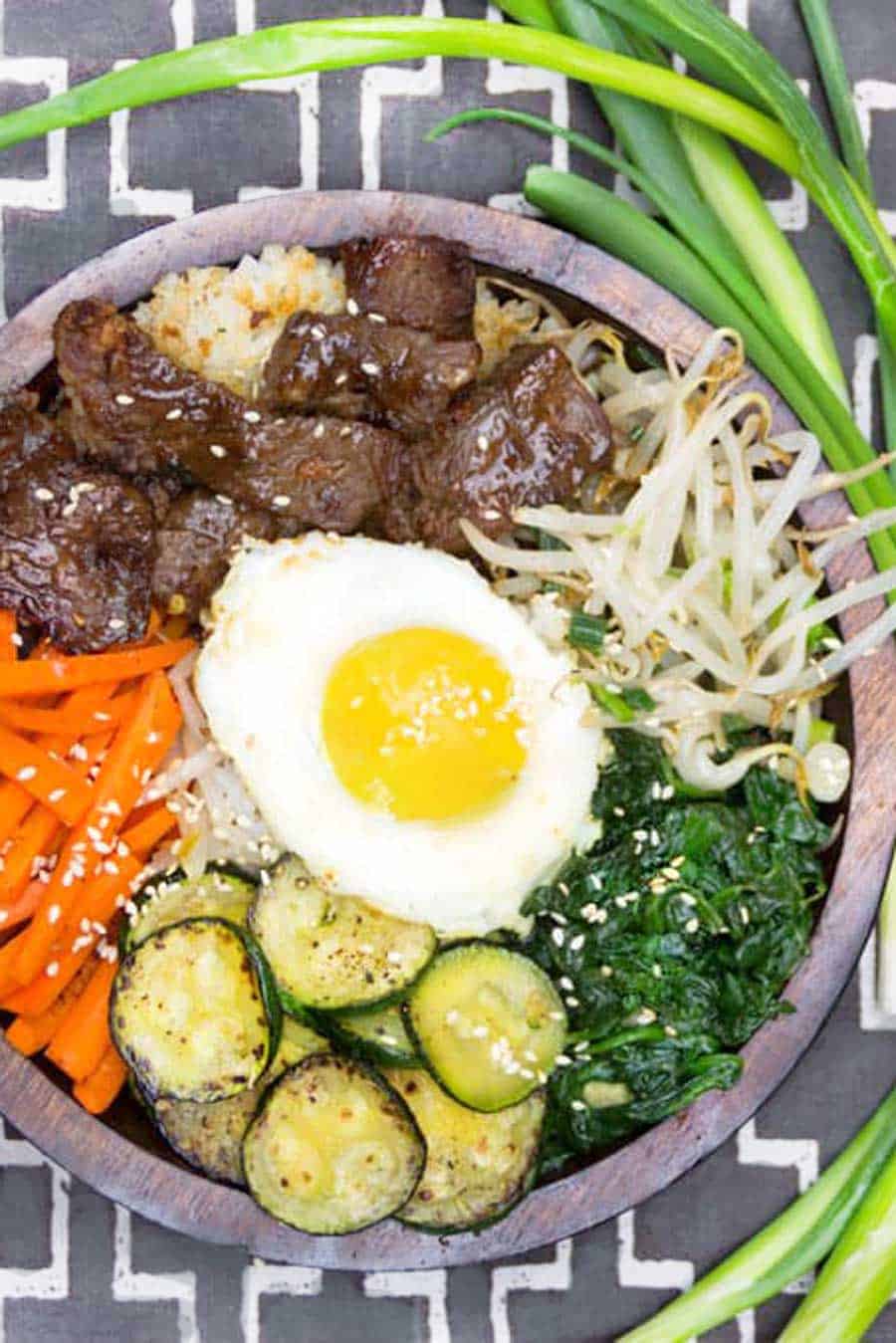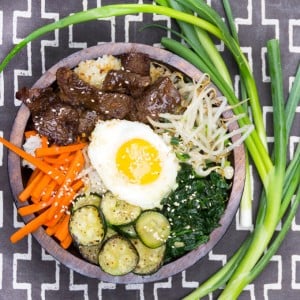It's easy to understand why Bibimbap is one of Korea's most popular dishes. Each person at the table gets his or her own individual bowl, filled with the most incredible arrangement of delicacies: crisped rice, assorted veggies, a fried egg, spicy sauce and, the star of the show, marinated Bulgogi beef.

Bibimbap means mixed rice in Korean. But the mixing part doesn't happen right away. The traditional way to serve bibimbap is to arrange each bowl with rice on the bottom and little colorful piles of beef and veggies on top. That way you can fully appreciate each of the beautiful ingredients separately before you mix them all together.
The two most outstanding elements of bibimbap are the bulgogi beef and the crisp rice. If you've ever tried bulgogi beef, you know how flavorful it is - sweet, salty, garlicky and irresistible. For the crisp rice, cold rice is seared in a hot pan until it develops a crust. That golden crispy crunchy rice with its nutty browned flavor adds a lot of excitement to the bibimbap.
How to make Korean Bibimbap
It may seem like bibimbap has an overwhelming amount of ingredients however Korean Bibimbap is not designed to be a complicated time-consuming meal. On the contrary, it's a recipe created to make use of leftovers.
-
- Leftover rice is repurposed and crisped up.
- Leftover vegetable side dishes, called banchan, are the toppings.
- Bibimbap is a flexible dish that can be as simple or elaborate as you choose. Sauté whatever veggies you have in house or make use of leftover vegetables from last night's dinner.
- Add kimchi, if you have it.
- Garnish bibimbap with thin ribbons of nori or a sprinkling of toasted sesame seeds.
- Follow my recipe or create your own but whatever you do, don't skip the amazing Bulgogi beef or the crisp rice!
How to make crisp rice for bibimbap
You'll need cooked short grain rice and a cast iron skillet.
- Cook up some short-grain white rice or sushi rice a few hours ahead or the day before, because you'll need cool cooked rice for this.
- Heat 1 tablespoon sesame in a cast iron skillet. Add the cooked rice to the pan and press it down firmly into the hot skillet with a spatula. Let the rice brown, undisturbed, for 10 - 15 minutes, or until it forms a crisp crust.
- If you want to go all out, you can purchase traditional Korean stone bowls called dolsots to crisp the rice and assemble the bibimbap.

Sauce for Bibimbap
The sauce for bibimbap features the spicy Korean fermented hot pepper paste called Gochujang. You can find it in the Asian section at many grocery stores. Gochujang is typically mixed with a little vinegar and sesame oil - sometimes sugar. But you can also use it straight up. It's sweet, savory, spicy and wonderful!

If you love Korean food, here are a few other delicious Korean recipes to try
- Korean Beef Lettuce Wraps Appetizer which I make every year on New Year's Eve
- Korean BBQ Burgers with Pickled Onions, Radishes and Miso Mayonnaise - the only burgers my family ever want.
- Korean Chicken Stew with Gochujang Sauce - A favorite easy weeknight dinner.
Here's the recipe for Korean bibimbap. If you make this I hope you'll come back to leave a star rating and a comment. I'd love to know what you think!
PrintRecipe

Bibimbap Recipe
- Total Time: 1 hour 15 mins
- Yield: 5 1x
Description
Korean rice bowls with Bulgogi marinated beef, crisp rice, assorted vegetables and fried eggs.
Ingredients
- 4 ½ cups cooked sushi rice or short grain rice (from 1 ½ cups raw rice) follow package directions.
- 1 tablespoon sesame oil for crisping the rice, if you choose to do that.
- 1 pound thinly sliced (⅛') beef tenderloin (or substitute ribeye, sirloin or flank)
- 2 tablespoons dark brown sugar
- 2 tablespoons soy sauce
- 1 tablespoon Asian sesame oil
- 2 teaspoons crushed garlic (2 medium cloves)
- ½ teaspoon crushed red pepper flakes
- For the Sauce:
- 5 tablespoons Korean gochujang (fermented hot pepper paste)
- 2 tablespoon Asian sesame oil
- 2 tablespoons vinegar (white or cider)
- For the Vegetables
- 2 tablespoons cooking oil, such as canola, divided
- 3 carrots, peeled and cut into matchsticks (see this post for how to cut carrots into matchsticks)
- 2 medium zucchini, sliced into thin rounds
- 1 garlic clove, minced
- 1 pound fresh baby spinach
- 1 teaspoon sesame oil
- 1 teaspoons soy sauce
- 1 ½ cups fresh Mung bean sprouts
- 5 eggs, cooked over easy or sunny side up.
- Optional Garnish:
- 3 tablespoons toasted sesame seeds
- A sheet of nori cut into thin ribbons
Instructions
Note: Be sure you have your rice cooked and ready.
- Marinate the Beef: In a shallow bowl, combine all the marinade ingredients: brown sugar (2 tablespoons), soy sauce (2 tablespoons), sesame oil (1 tablespoon), garlic (2 teaspoons), and red pepper flakes (½ teaspoon). Add the beef and toss to coat. Marinate for at least 30 minutes at room temp or up to 24 hours in the fridge, covered.
- To make the spicy sauce, whisk the gochujang (5 tablespoons), sesame oil (2 tablespoons) and vinegar (2 tablespoons). Sauce can be stored in the fridge for up to a week.
- Blanch the fresh spinach by dropping it into a large pot of boiling water and letting it sit for 1 minute or so, until it's bright green and wilted. Drain in a colander and run cold water over it to stop the cooking process. Squeeze it by hand, to remove excess water and toss it in a small bowl with 1 teaspoon sesame oil and 1 teaspoons soy sauce.
- Blanch the sprouts in a pot of boiling water for 1 ½ minutes. Drain and toss with ½ teaspoon sesame oil and salt and pepper, to taste. Sprinkle with ½ teaspoon sesame seeds.
- To crisp the Rice, spread 1 tablespoon of sesame oil over the bottom of a large cast iron skillet and turn the heat to medium. When hot but not smoking add the cooked rice to the pan, pressing it down into the pan with a spatula, for maximum contact with the bottom and sides of the hot skillet. Let it brown, undisturbed, for 10 - 15 minutes, or until it forms a crisp crust. (Lift the edge carefully to check it after 10 min)
- While the rice is browning, cook the eggs, Fry the eggs in a separate pan. You can keep them warm on a baking sheet in a 200ºF oven.
- To cook the zucchini, heat oil (1 teaspoon) over medium-high heat in a wok or skillet and stir-fry the zucchini and garlic (1 clove minced) for 5 minutes or so, until cooked through. Transfer to a bowl and sprinkle with some toasted sesame seeds, if you like.
- To cook the carrots, add oil (½ teaspoon) to the wok or skillet and stir-fry the carrots for 3 minutes or so, until crisp-tender. Transfer to a bowl and sprinkle with a pinch of salt.
- To cook the beef, heat oil (1 tablespoon) in a skillet over high heat. Stir-fry half the beef for 1 ½ - 2 minutes or until it's just cooked through. Transfer to a plate and repeat with remaining beef.
- To assemble the bowls, divide rice between 5 large bowls. Divide beef and vegetables and arrange them in little piles on top of the rice. Put a fried egg on top of each bowl. Garnish with sesame seeds and nori, if you like. Pass the sauce around.
- Prep Time: 45 mins
- Cook Time: 30 mins
- Category: Main Dish
- Method: Sauté
- Cuisine: Korean








Tim Demanchyk
I just purchased some korean gochujang after seeing it on the Try Guys cookie baking episode. I was not planning on putting it in any cookies and I stumbled upon this recipe. It was a big success, and 'Bibimbap' is so fun to say!